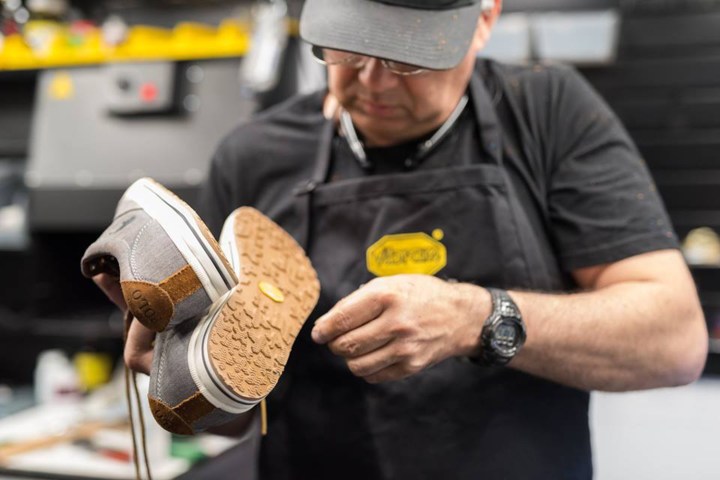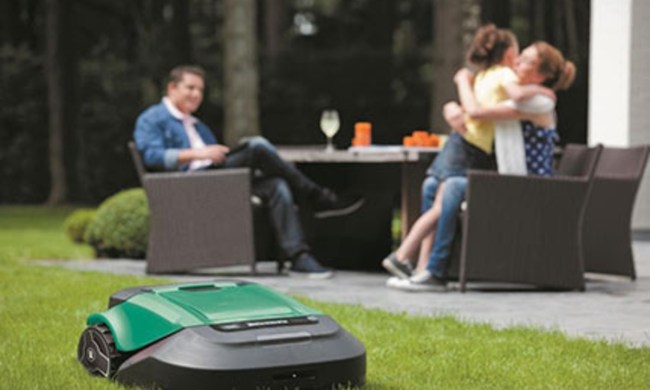
When Vibram’s FiveFingers shoes first launched in 2005, the refreshingly naturalist, if slightly goofy-looking shoes were met with a wave of ardent enthusiasm that gave rise to an almost cultlike following. Across the globe, runners were stripping off their thickly padded Nikes and New Balances to run through the woods with little more than a strip of rubber between their feet and the ground.
In the years that followed, other brands hopped on board. Adidas released a pair of toe shoes for gym use called the AdipureTrainers. Fila launched a four-toed version called Skele-toes. For a while, it appeared as though traditionally cushioned footwear may be on its way out. Yet, as with most fads, the craze eventually settled down and the market recalibrated itself. Mainstream footwear manufacturers began focusing on their full quiver of cushioning while Vibram continued carving out its niche among the die-hards.
Today, 13 years after the launch of the first FiveFingers shoes, barefoot running appears to be having another moment — a “second barefoot revolution,” if you will. Vibram is currently on the road with its Sole Factor tour for the fourth straight year, resoling old shoes for consumers nationwide. Meanwhile, brand executives say the company has seen significant growth over the past three years. Some of this spike may be attributed to new technology the brand is developing.
According to Chris Melton, Vibram’s director of sales and distribution for finished goods, the company has made innovations in its rubber compounds and upper textiles that offer more optimal grip and better bacteria control. The soles are better equipped to grip various surfaces, whether they be trails, wet rocks, smooth pavement, or gym floors. The climate is now ripe, he said, for a barefoot resurgence.
“Whether it be cars, homes, the things we keep, or the clothes we wear, many people are going the ‘less is more’ route,” Melton said.
What is barefoot technology?
For those unfamiliar with barefoot running, the concept is that by stripping away the extra cushioning and freeing your toes from the confines of traditional shoes — or “foot coffins,” as barefoot proponents call them — you allow your foot to move more naturally. This develops all of your foot’s micro-muscles while enhancing dexterity and proprioception. Tyler Allan, Vibram’s sole factor lead, explained that overly cushioned shoes suppress the foot’s natural functioning.
“Your feet are so complex,” Allen said. “It’s 33 joints in each foot. There are hundreds of ligaments and muscles and tendons. A quarter of your bones are in your feet. So we have really, really complex feet that work really well for our anatomy and our bodies. When we mask that and we put lots of cushioning and all sorts of stuff, you take a lot of that away.”

It comes down to being in tune with your body, he said, and being able to receive feedback from your feet when they’re in contact with the ground. For example, when you’re standing barefoot, your feet give you natural cues like how not to lean on one leg too long. Or when you’re running barefoot, they indicate things like how to strike the ground with your forefoot rather than your heel.
“It’s basically an awareness thing,” he said. “Your feet give you so much information. On how to stand. On how to run. On how to walk. All that stuff. Ideally, we would (recommend) you go barefoot as much as you can in life.”
What the experts say
Dr. Cassandra Tomczak, podiatric surgeon with Summit Orthopaedics in Portland, Oregon, said there is definitely a place for minimalist footwear. She’s seen patients have great success with the transition but added that people need to be informed and cautious. When you’ve worn supportive shoes your whole life, your feet grow accustomed to them. If you suddenly remove that support, it can be hard on your feet.
“People try to transition directly into a Vibram shoe and with that, they can develop stress injuries,” Tomczak said. “Stress fractures, tendinitis, (and) plantar fasciitis are some of the most common injuries I see when people transition too quickly.”
It can be challenging to pinpoint why certain injuries or conditions occur but going to a minimalist shoe without allowing your feet to adapt is one thing she’s seen lead to overuse injuries.
When you change to a minimalist shoe, your stride shortens, your heel strike decreases, and more time is spent on your forefoot.
The issue, she said, is that your gait changes when you switch to minimalist shoes. Most classic running shoes are designed for a gait that consists of a heel strike, followed by a roll through the outside of your foot, over the ball of your foot, and ending off your big toe. When you change to a minimalist shoe, your stride shortens, your heel strike decreases, and more time is spent on your forefoot. If you don’t adjust appropriately, it can increase the risk of injury.
Despite the need for caution, Tomczak emphasized that when done properly, a transition to minimalist footwear can actually be a fantastic change. In fact, there’s been a shift in the medical community in recent years that favors minimalist footwear, she said. In pediatrics, for example, doctors are largely discouraging stiff, highly supportive footwear for children under the age of two, instead recommending sock-like options.
“When you’re born, a lot of the foot bones aren’t there yet, so you can stunt the growth,” said Tomczak. “When you think back to those shoes that we were in, that our parents were in, they were these stiff leather shoes. (In those), our musculature isn’t able to develop properly. … That’s why people develop fatigue and overuse injuries when going directly to a minimalist shoe.”
How to make the change
When transitioning, you should approach it similarly to how you’d train for a marathon, Tomczak said. It should involve strengthening your muscles and cross-training, rather than just jumping into running right away. Begin by wearing your new shoes around the house, she said, doing light-impact activities. Next, start running lightly.
“Don’t go for your full run,” she said. “Maybe just run a mile. Maybe go one mile and then go back to your typical shoes. And then gradually build up that strength.”

Vibram’s Melton agreed, noting that new customers should always transition slowly.
“It’s likely that the muscles in their legs and feet will be working in a way they may not be accustomed to,” Melton said. “So those muscles will need to transition and become stronger. Soreness is normal, pain is not.”
Tomczak pointed to a number of exercises you can do to prepare your feet. Specific recommendations vary from person to person but will often be similar to things you’d do in a yoga class. Exercises like balancing on one foot or rolling onto your toes, as well as routines that focus on toe strength and flexibility — gripping things with your toes, using them to lift objects, spreading them out, or moving them independently of one another, for instance.
Success varies by individual
Even with exercise, however, Tomczak stressed that some feet simply won’t be able to acclimate to barefoot shoes no matter how much you train. This is due largely to genetics.
“It’s important to recognize that there’s this continuum and you might not fit into that Vibram shoe regardless of how much you try,” she said. “You can strengthen forever but if you have anatomical alignment that is going to predispose your arch to collapse, you might need something with more of an arch support.”
“I think the key is that this barefoot technology can be great, but people shouldn’t feel bad if they (can’t wear them) because some feet are just going to need more support.”
A long history
While Vibram is undoubtedly most famous for its FiveFingers toe shoes, the company has actually been making soles since 1937. In fact, if you go to any shoe store and start flipping over shoes, chances are you’ll see the Vibram logo pop up fairy quickly. The company has worked with more than a thousand footwear makers including mega-giants like North Face, Merrell, New Balance, and the U.S. military.
It all began in the 1930s when Italian mountaineer Vitale Bramani (Vi + Bram = Vibram) led a climbing expedition through the rugged Alps. According to the story, 10 men went up but only four came back down. Six fell to their deaths due to lack of traction and the harrowing event moved Bramani to develop a better sole for climbing boots. He got a hold of Pirelli tires and asked if he could use their rubber scraps to begin formulating a sole. Soon, he’d developed the Carrarmato (“tank tread”), the first sole ever created with rubber lug soles. Vibram became the first company to use vulcanized rubber for footwear.
What goes into a high-quality sole?
Making a good footwear sole comes down to two factors: The type of rubber compound and the type of tread pattern. It’s a delicate blend of chemistry and creative design. To this day, Vibram’s top-secret recipe for its rubber compounds, combined with its patented tread design, is what makes the company stand out. It currently has roughly 50 different compounds, the most popular of which are the MegaGrip and the Arctic Grip. The latter is designed for wet ice and used in some of Merrell’s most famous winter boots.
“The compound is really where the durability comes in,” said Allen. “You can have an awesome tread pattern and if you’re walking up a mountain and you feel it grabbing, that’s great. But the real test is, ‘How durable is it? How long it it going to last? … Our competitors make great shoes in terms of minimalism but you’re not going to get the same sole quality.”
How are the soles made?
Vibram makes two types of soles — a tough rubber sole and a lighter one from EVA foam. The process for making the former involves mixing up big batches of molten goop and running it through a machine that, given the company’s Italian heritage, merits an appropriate analogy.
“They roll it through like how you make pasta,” Allen said. “You keep feeding it through the system to smooth it out and get all the air out of it. If you picture how you feed the flour and the pasta through a machine, it presses it and it comes out. They take it and feed it back through (and) then it hardens.”

Since the launch of FiveFingers, the brand has added countless variations to the original style (which some folks found less than fashionable). Today, closure systems include things like straps, laces, and slip-ons. There are different tread patterns and the upper materials range from hemp to synthetics to nylon to breathable mesh. Vibram recently launched an amphibious shoe called the V-Aqua, as well as lifestyle line called Furoshiki.
The latter is essentially an outdoor slipper that offers a more fashionable aesthetic for people who want the barefoot technology but don’t like the way the toe design looks. It features a minimally constructed Vibram sole with fabric to wrap around your feet.
The philosophy
There are a lot of reasons to love Vibram’s ever-evolving barefoot line, Allen said, but it’s perhaps the intangible, more philosophical benefits that make the best argument for them. Feeling the ground beneath you when you’re outside, he said, is an amazing sensation.
“When you walk around, in the woods, in the mountains,” he said, “When you’re out in nature and you’re feeling the sticks and stones in the dirt, there is just something about it. It’s part of us. This is who we are.Feeling the ground and feeling nature with your feet — it’s not something that everyone will even realize is happening. But it’s so powerful, as human beings, to walk around it and feel it.”





